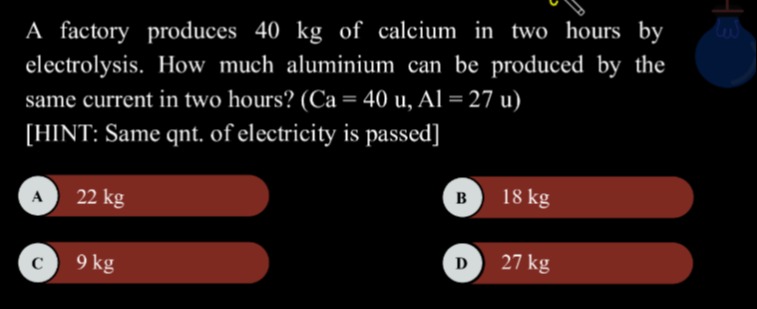Question
Question: A factory produces 40 kg of calcium in two hours by electrolysis. How much aluminium can be produced...
A factory produces 40 kg of calcium in two hours by electrolysis. How much aluminium can be produced by the same current in two hours? (Ca = 40 u, Al = 27 u) [HINT: Same qnt. of electricity is passed]

22 kg
18 kg
9 kg
27 kg
18 kg
Solution
According to Faraday's second law of electrolysis, when the same quantity of electricity is passed through different electrolytes, the masses of the substances deposited or liberated at the electrodes are directly proportional to their equivalent weights.
The equivalent weight (E) of a substance is given by its atomic mass (M) divided by its valency (v).
E=vM
For calcium (Ca), the atomic mass MCa=40 u. In electrolysis producing calcium metal, the ion is Ca2+, so the valency vCa=2. The equivalent weight of calcium is ECa=vCaMCa=240=20.
For aluminium (Al), the atomic mass MAl=27 u. In electrolysis producing aluminium metal, the ion is Al3+, so the valency vAl=3. The equivalent weight of aluminium is EAl=vAlMAl=327=9.
We are given that 40 kg of calcium is produced (WCa=40 kg). The same current is passed for the same time (2 hours), which means the same quantity of electricity is used for both calcium and aluminium production.
Applying Faraday's second law:
ECaWCa=EAlWAl
Substitute the known values:
2040=9WAl
Simplify the left side:
2=9WAl
Solve for WAl:
WAl=2×9=18 kg
Therefore, 18 kg of aluminium can be produced by the same current in two hours.
